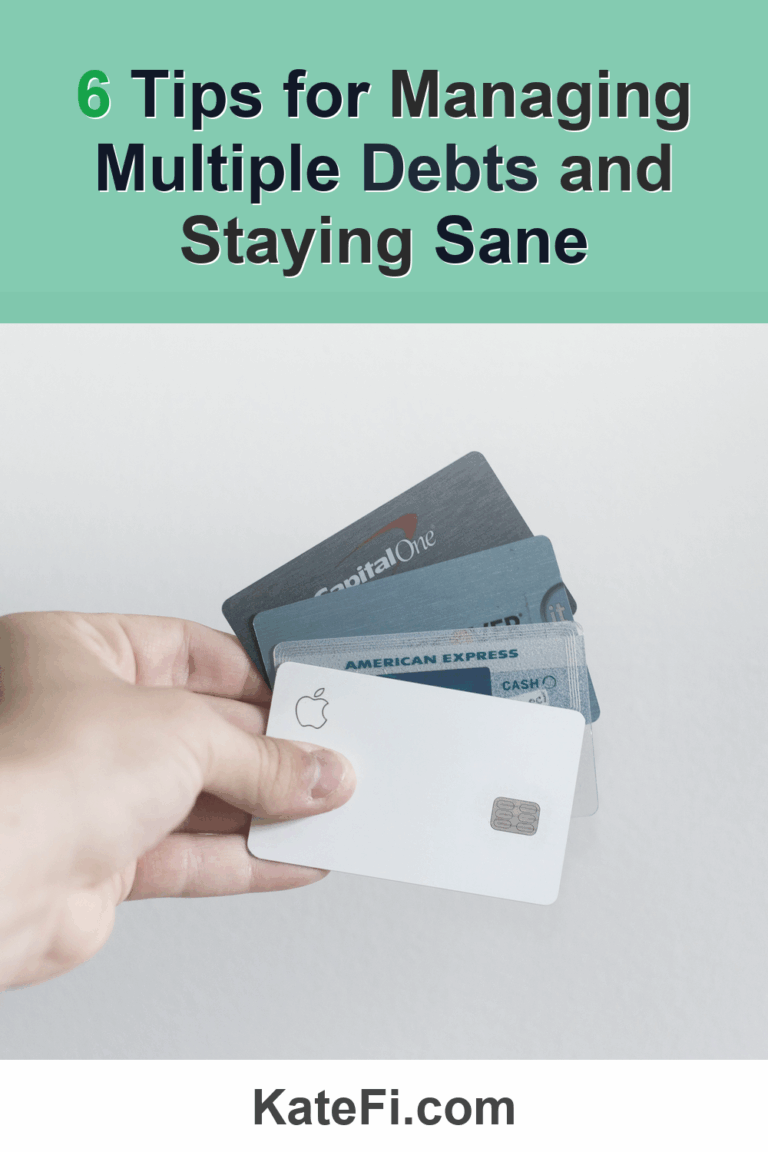6 Tips for Managing Multiple Debts and Staying Sane
Navigating through multiple debts can often feel like a juggling act—one wrong move, and everything comes crashing down. When you’re managing credit cards, student loans, and maybe a mortgage all at once, it’s easy to become overwhelmed and feel as though you’re on a never-ending cycle of payments. But don’t lose hope! By implementing smart strategies, you can regain control over your financial situation, stay sane, and potentially pave the way for debt relief.
Love our content? Show your support by following us — pretty please!🥺
FOLLOW ON PINTEREST
Hi! I’m Kate, the face behind KateFi.com—a blog all about making life easier and more affordable.
Before we dive into the essential tips, let’s debunk some common myths surrounding debt and credit. Understanding these misconceptions is the first step to making informed decisions about managing your finances.
Myth vs. Fact: Common Misconceptions About Debt and Credit
Lower Your Unsecured Debt
If you have $5,000+ in credit card or personal loan debt, a free consult can review options like settlement or hardship plans.
- One-on-one call to review your debts and goals
- See potential monthly payment reductions
- No obligation to enroll
Not available in IL, KS, OR, TN, UT, WV.
Myth 1: Debt Relief Will Ruin My Credit Score
Fact: While some debt relief options may temporarily impact your credit score, many people see their scores recover over time as they pay off debts and manage their finances responsibly.
Myth 2: Ignoring My Debts Will Make Them Go Away
Fact: Ignoring debts often leads to additional fees, interest, and potential legal action. Facing your debts head-on is the best approach.
Myth 3: I Need to Be Rich to Afford Debt Relief Services
Fact: Many debt relief options are designed for people of all income levels. Getting a free consultation can help you understand your specific situation and options available.
Myth 4: All Debt Relief Companies Are Scams
Fact: While there are certainly bad actors, many reputable companies offer legitimate debt relief services. It’s important to do your research and read reviews.
Myth 5: I Can’t Negotiate with Creditors
Fact: Most creditors are open to negotiation, especially if you communicate proactively. They often prefer to work out a payment plan than send your account to collections.
Myth 6: I Should Always Pay Off the Highest Interest Debt First
Fact: While paying off high-interest debt can save money, it’s not the only strategy. Consider psychological factors—paying off smaller debts can provide motivation.
Myth 7: A Debt Settlement Will Fully Clear My Debt
Fact: Debt settlement can reduce what you owe, but it doesn’t erase it entirely. There might still be tax implications and fees involved.
Understanding these myths can empower you to take action in managing your debts. If you’re ready to explore your options, consider getting a free consultation to review available debt relief options.
Tip #1: Create a Realistic Budget
One of the most effective ways to manage multiple debts is by establishing a budget that truly reflects your income and expenses. This budget isn’t just a piece of paper; it’s a financial roadmap to help you allocate resources wisely.
Checklist for Budget Creation:
- List all income sources: Include your salary, side jobs, and any passive income.
- Identify fixed and variable expenses: This includes rent, utilities, groceries, entertainment, etc.
- Include debt payments: Make sure to account for your minimum payments for each debt.
- Set aside an emergency fund: Aim to save at least 3-6 months’ worth of expenses.
Creating a budget that actually sticks involves regular reviews and adjustments based on your lifestyle changes and income fluctuations.
Tip #2: Prioritize Your Debts
👉 Start Your Free Debt Relief Review
Not available in IL, KS, OR, TN, UT, WV.
Now that you have a budget, it’s essential to prioritize your debts. This may involve focusing on high-interest debts or those that are causing the most stress.
Comparison Table: Debt Prioritization Methods
| Method | Description | Pros | Cons |
|---|---|---|---|
| Avalanche Method | Pay off debts from highest to lowest interest rate. | Saves money on interest. | Can be slow motivation-wise. |
| Snowball Method | Pay off smallest debts first for quick wins. | Builds motivation quickly. | May pay more in interest. |
| Equal Payment Method | Distribute extra funds evenly among all debts. | Simple and easy to manage. | Progress may be slower. |
Choose the method that resonates with you the most, or even combine elements from each.
Tip #3: Open Communication with Creditors
Don’t underestimate the power of open communication. Creditors are often willing to work with you if you reach out proactively.
Scripts for Communicating with Creditors:
- When requesting a lower interest rate:
“Hello, I’m reviewing my finances and wanted to ask if there are any options to reduce my interest rate. I’ve been a loyal customer for [X years].”
- When negotiating payments:
“I’m currently facing some financial difficulties, and I’d like to discuss my payment options. Is there any way we can work out a temporary arrangement?”
Communicating effectively can lead to better repayment terms and can alleviate some of the financial burden.
Tip #4: Explore Debt Relief Options
What You’ll Learn on the Call
- Estimated timeline and monthly payment range
- How credit may be affected in the short term
- What documents to gather to move faster
Not available in IL, KS, OR, TN, UT, WV.
If you find yourself drowning in multiple debts, exploring debt relief options may be a viable path. This could include debt settlement, debt management plans, or even bankruptcy in extreme cases.
Don’t hesitate to get a free consultation to understand what options best suit your unique situation. The right professional guidance can help you navigate these complicated waters effectively.
Tip #5: Build a Support System
Understand pros/cons of settlement vs consolidation vs DMP for your exact mix of debts.
Not available in IL, KS, OR, TN, UT, WV.
Dealing with debt can be isolating, but it doesn’t have to be. Building a support system can provide emotional relief as well as practical advice.
How to Build Your Support System:
- Reach out to friends and family: Let them know what you’re going through. They may offer practical help or simply a listening ear.
- Join support groups: Many communities and online platforms offer groups specifically for those dealing with debt.
- Consult financial advisors: Professional advice can guide you in making informed decisions.
Having a strong support system can help alleviate the mental burden that comes with financial stress.
Tip #6: Monitor and Adjust Your Progress
Just because you’ve created a budget and started making payments doesn’t mean you can set it and forget it. Continuous monitoring and adjustments are crucial for long-term success.
Practical Steps for Monitoring Progress:
- Monthly Check-Ins: Review your budget and make sure you’re sticking to it.
- Track your debts: Use apps or spreadsheets to keep an eye on your balances and payments.
- Celebrate Milestones: Whenever you pay off a debt, no matter how small, take a moment to acknowledge your progress.
Credit Impact and Documentation
It’s important to be aware that various debt relief options can impact your credit. While seeking relief might lead to a temporary dip in your score, making consistent payments post-relief can help improve it over time. To expedite any consultations regarding debt relief, gather essential documents including:
- Credit report: To understand your debts.
- Income statements: Such as pay stubs or tax returns.
- Monthly expenses: A detailed account of your regular expenditures.
This documentation will not only speed up the review process but will also provide a clearer picture of your financial health.
Conclusion: The Path to Financial Freedom
Managing multiple debts can feel overwhelming, but it’s important to remember that there are actionable steps you can take to regain control. Whether it’s creating a budget, prioritizing payments, or seeking professional help, small changes can lead to significant results over time.
As you embark on this journey, don’t hesitate to get a free consultation and explore your debt relief options. You don’t have to navigate this path alone; with the right guidance and a strong support system, you can find the financial freedom you seek.
Important: This content is for education only—not legal, tax, or financial advice. Results and eligible programs vary by situation and state. Fees apply if you enroll and complete a program. Debt relief can affect credit; missed payments may lead to collections/lawsuits. Not available in IL, KS, OR, TN, UT, WV.
Taking these steps can set you on the right path toward financial stability and peace of mind. Start today!






















